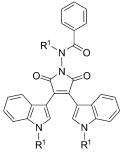| References1 Tamaoki, T.; Nomoto, H.; Takahashi, I.; Kato, Y.; Morimoto, M.; Tomita, F. Biochem. Biophys. Res. Commun. 1986, 135, 397.2 Zhao, S.-Y.; Shao, Z.-Y.; Qin, W.-M.; Zhang, D.-Q. J. Org. Chem. 2008, 28, 1676(in Chinese). (赵圣印, 邵志宇, 钦维民, 张灯青, 有机化学, 2008, 28,1676.)3 Li, Q.-Q.; Li, Z.; Qin, J.-G. Prog. Chem. 2009, 21, 2578 (李倩倩,李振,秦金贵. 化学进展, 2009, 21, 2578)4 Yeh, T. S.; Chow, T.J.; Tsai, S.H.; Chiu, C.W.; Zhao, C. Chem. Mater. 2006, 18, 832.5 Lin, Z.; Wen, Y. S.; Chow, T.J. J. Mat. Chem. 2009, 19, 5141.6 Nakazono, M.; Nanbu, S.; Uesaki, A.; Kuwano, R.; Kashiwabara, M.; Zaitsu, K. Org. Lett.2007, 9, 3583.7 Li, Y.; Cao, L.-F.; Ning, Z.-J.; Huang, Z.; Cao,Y.; Tian, H. Tetrahedron Lett. 2007, 48, 975.8 Ning, Z.-J.;Zhou, Y.; Zhang, Q.; Ma, D.-G.; Zhang, J.-J.; Tian,H. J. Photochem. Photobiol., A. 2007, 192, 8.9 Zhao, S.Y., Mo, S.W., Chen, Z.L., Yue, Y., Sun, Y. J. Chem. Res., 2009, 198.10 Jiang, D.-F.; Yang, Y.-W.; Shao, Z.-Y; Zhao, S.-Y. Lett. Org. Chem. 2010, 7, 144.11 Malthete, J.; Canceill, J.; Gabard, J.; Jacques, J. Tetrahedron 1981, 37, 2815. 12 Brenner, M.; Rexhausen, H.; Steffan,B.; Steglich, W. Tetrahedron 1988, 44, 2887.13 Faul, M. M.; Sullivan, K. A.; Winneroski, L. Synthesis 1995, 1511.14 Pereira, E. R.; Fabre, S.; Sancelme, M. J. Antibiot. 1995, 48, 863.15 Tsaklakidis, C.; Schultz, M.; Haag, R.; Scheuer, W.; Russmann, E. DE4005969 1991. (Chem Abstr. 1990, 115, 232077). 16 Chisholm, J.D.; Van Vranken, D.L. J. Org. Chem. 2000, 65, 7541. 17 Corey, E. J.; Mock, W. L.; Pasto, D. J. Tetradedron Lett. 1961, 2, 353. 18 Kaletas, B. K.; Mandl,C.; van der Zwan, G.; Fanti, M.; Zerbetto, F.; De Cola, L. D.; Konig,B.; Williams, R. M. J. Phys. Chem. A, 2005, 109, 6440. |
